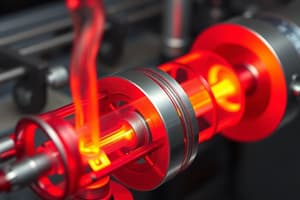Podcast
Questions and Answers
A rigid container holds an ideal gas. If heat is added to the gas, how does this affect its internal energy and why?
A rigid container holds an ideal gas. If heat is added to the gas, how does this affect its internal energy and why?
The internal energy increases because, with constant volume (rigid container), no work is done. Therefore, all the heat added goes directly into increasing the internal energy of the gas, according to the first law of thermodynamics.
Explain how the efficiency of a Carnot engine changes if the temperature of the hot reservoir is increased, while the temperature of the cold reservoir remains constant.
Explain how the efficiency of a Carnot engine changes if the temperature of the hot reservoir is increased, while the temperature of the cold reservoir remains constant.
The efficiency of the Carnot engine increases. This is because the Carnot efficiency is given by $η = 1 - (T_C/T_H)$. Increasing $T_H$ while keeping $T_C$ constant decreases the ratio $T_C/T_H$, leading to a higher efficiency.
Describe the key difference between an isothermal process and an adiabatic process in terms of heat transfer and temperature change.
Describe the key difference between an isothermal process and an adiabatic process in terms of heat transfer and temperature change.
In an isothermal process, the temperature remains constant, and heat is exchanged with the surroundings to maintain this constant temperature. In an adiabatic process, there is no heat exchange with the surroundings, and the temperature changes as a result of work done on or by the system.
How does the concept of entropy relate to the second law of thermodynamics, and what does it imply for irreversible processes?
How does the concept of entropy relate to the second law of thermodynamics, and what does it imply for irreversible processes?
Consider a gas expanding freely into a vacuum. What can you say about the work done and the change in internal energy during this process?
Consider a gas expanding freely into a vacuum. What can you say about the work done and the change in internal energy during this process?
Explain the difference between a state function and a path function in thermodynamics, providing examples of each.
Explain the difference between a state function and a path function in thermodynamics, providing examples of each.
What is the significance of the Gibbs free energy in determining the spontaneity of a process at constant temperature and pressure?
What is the significance of the Gibbs free energy in determining the spontaneity of a process at constant temperature and pressure?
Describe how the coefficient of performance (COP) differs between a refrigerator and a heat pump. Which one is generally greater and why?
Describe how the coefficient of performance (COP) differs between a refrigerator and a heat pump. Which one is generally greater and why?
Explain the physical meaning of the third law of thermodynamics and its implications for reaching absolute zero.
Explain the physical meaning of the third law of thermodynamics and its implications for reaching absolute zero.
In the context of phase transitions, explain what latent heat is and how it relates to a first-order phase transition.
In the context of phase transitions, explain what latent heat is and how it relates to a first-order phase transition.
Flashcards
System (Thermodynamics)
System (Thermodynamics)
Part of the universe under study.
Surroundings (Thermodynamics)
Surroundings (Thermodynamics)
Everything outside the system.
Isolated System
Isolated System
No exchange of matter or energy with the surroundings.
Closed System
Closed System
Signup and view all the flashcards
Open System
Open System
Signup and view all the flashcards
Thermodynamic Equilibrium
Thermodynamic Equilibrium
Signup and view all the flashcards
Zeroth Law of Thermodynamics
Zeroth Law of Thermodynamics
Signup and view all the flashcards
First Law of Thermodynamics
First Law of Thermodynamics
Signup and view all the flashcards
Isothermal Process
Isothermal Process
Signup and view all the flashcards
Adiabatic Process
Adiabatic Process
Signup and view all the flashcards
Study Notes
- Thermodynamics is the study of energy, its transformations, and its relation to matter
Basic Concepts
- System: Part of the universe under study
- Surroundings: Everything outside the system
- Boundary: Surface separating the system from its surroundings
- Types of systems:
- Isolated system: No exchange of matter or energy with the surroundings.
- Closed system: Exchange of energy but not matter with the surroundings.
- Open system: Exchange of both matter and energy with the surroundings.
- Thermodynamic properties: Macroscopic properties of a system such as temperature (T), pressure (P), and volume (V).
- State of a system: Defined by the values of its macroscopic properties.
- Thermodynamic process: A change in the state of a system.
- Thermodynamic equilibrium: State where macroscopic properties are uniform throughout the system and do not change with time. Includes thermal, mechanical, and chemical equilibrium.
Zeroth Law of Thermodynamics
- If two systems are separately in thermal equilibrium with a third system, then they are also in thermal equilibrium with each other.
- This law introduces the concept of temperature as a fundamental property that determines thermal equilibrium.
First Law of Thermodynamics
- The change in internal energy (ΔU) of a system is equal to the heat added to the system (Q) minus the work done by the system (W): ΔU = Q - W.
- Internal energy (U) is a state function, dependent only on the current state of the system, not on how it reached that state.
- Heat (Q) is the transfer of energy due to temperature difference.
- Work (W) is the transfer of energy by any other means than temperature difference, like a force acting through a distance.
- For an isolated system, ΔU = 0, meaning energy is conserved.
Types of Processes
- Isothermal process: Occurs at constant temperature (ΔT = 0).
- For an ideal gas, ΔU = 0, so Q = W.
- Adiabatic process: No heat exchange with the surroundings (Q = 0).
- ΔU = -W.
- Isobaric process: Occurs at constant pressure (ΔP = 0).
- W = PΔV.
- Isochoric process: Occurs at constant volume (ΔV = 0).
- W = 0, so ΔU = Q.
- Cyclic process: The system returns to its initial state.
- ΔU = 0, so Q = W.
Second Law of Thermodynamics
- It is impossible to construct a device that operates in a cycle and produces no effect other than the transfer of heat from a colder body to a hotter body (Clausius statement).
- It is impossible to construct a device that operates in a cycle and converts heat completely into work without transferring some heat to a colder body (Kelvin statement).
- Introduces the concept of entropy (S), a measure of the disorder or randomness of a system.
- For a reversible process, the change in entropy is given by ΔS = Q/T.
- For an irreversible process, ΔS > Q/T.
- The total entropy of an isolated system always increases or remains constant in a reversible process (ΔS ≥ 0).
Heat Engines
- A device that converts thermal energy into mechanical work.
- Operates in a cyclic process.
- Efficiency (η) is the ratio of the work done to the heat absorbed: η = W/QH = (QH - QC)/QH = 1 - (QC/QH), where QH is the heat absorbed from the hot reservoir and QC is the heat rejected to the cold reservoir.
- Carnot engine: A theoretical engine operating in a Carnot cycle, which consists of two isothermal processes and two adiabatic processes.
- Carnot efficiency: The maximum possible efficiency for a heat engine operating between two temperatures: ηCarnot = 1 - (TC/TH), where TC is the absolute temperature of the cold reservoir and TH is the absolute temperature of the hot reservoir.
Refrigerators and Heat Pumps
- A refrigerator transfers heat from a cold reservoir to a hot reservoir, requiring work input.
- A heat pump transfers heat from a cold reservoir to a hot reservoir.
- Coefficient of Performance (COP) for a refrigerator: COP = QC/W, where QC is the heat removed from the cold reservoir and W is the work input.
- COP for a heat pump: COP = QH/W, where QH is the heat delivered to the hot reservoir and W is the work input.
- For a Carnot refrigerator/heat pump: COPCarnot,refrigerator = TC/(TH - TC) and COPCarnot,heat pump = TH/(TH - TC).
Third Law of Thermodynamics
- As the temperature approaches absolute zero (0 K), the entropy of a system approaches a minimum or zero value.
- It is impossible to reach absolute zero in a finite number of steps.
Thermodynamic Potentials
- Internal Energy (U): Energy associated with the microscopic components of a system. U = U(S, V, N), where S is entropy, V is volume, and N is the number of particles.
- Enthalpy (H): H = U + PV. H = H(S, P, N). Useful for constant pressure processes.
- Helmholtz Free Energy (F): F = U - TS. F = F(T, V, N). Useful for constant temperature and volume processes.
- Gibbs Free Energy (G): G = U + PV - TS = H - TS. G = G(T, P, N). Useful for constant temperature and pressure processes, especially phase transitions and chemical reactions.
Maxwell's Relations
- Mathematical relationships derived from the thermodynamic potentials that relate changes in thermodynamic properties.
- Useful for calculating properties that are difficult to measure directly.
- Examples:
- (∂T/∂V)S,N = -(∂P/∂S)V,N
- (∂T/∂P)S,N = (∂V/∂S)P,N
- (∂S/∂V)T,N = (∂P/∂T)V,N
- -(∂S/∂P)T,N = (∂V/∂T)P,N
Phase Transitions
- A transition between different physical states of matter (solid, liquid, gas, plasma).
- First-order phase transition: Involves a latent heat (heat absorbed or released during the transition) and a discontinuity in the first derivative of the Gibbs free energy (e.g., melting, boiling).
- Second-order phase transition: No latent heat, but a discontinuity in the second derivative of the Gibbs free energy (e.g., change in magnetization in a ferromagnet).
- Clausius-Clapeyron equation: Describes the relationship between pressure and temperature along a phase boundary: dP/dT = L/(TΔV), where L is the latent heat and ΔV is the change in volume during the phase transition.
Studying That Suits You
Use AI to generate personalized quizzes and flashcards to suit your learning preferences.




